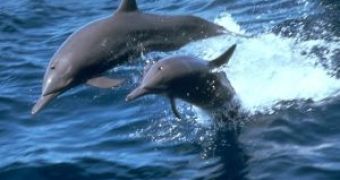The behavior and biology of dolphins caught the attention of humans since antiquity.
But their ability to train, their intelligence, memory, the lack of coagulant factor from the blood, their ability to dive to great depths without the peril of gas embolism have triggered the interest of the researchers.
The creation of oceanaria eased the research on dolphins, as they are much harder to study in the wild. They possess a high ability to learn and an impressive long-term memory. Dolphins do not imitate mechanically movements they are shown, but establish a link between gestures, voice and the trainer's intention and what they have to do.
There are many urban legends or sailors Tails counting about their intelligence and goodwill towards human beings: shipwrecked persons helped or sustained to reach the shore or dolphin groups that headed fishing boats towards fish shoals.
In some harbors, individuals turned in local mascots, coming regularly at the same spots for decades. Sometimes, dolphins asked for human help in case of a fellow entangled in a fish net or a wounded offspring.
Dolphins belong to the order of cetaceans, which also includes the whales. There are 88 species of cetaceans, but 73 are dolphins or the so-called toothed whale. Cetaceans are marine mammals which 50 million years ago evolved from terrestrial hoofed mammals, and which are related to current hippopotamus.
When hunting or exploring their environment, the dolphins use echolocation employing ultrasounds, while on long journeys they seem to use the Earth's electromagnetic fields, two orientation systems also used by ? bats!
Dolphins' intelligence is boosted by an unusual big brain (photo center, below).
A 120 kg dolphin possesses a 1.7 kg brain, while the human brain weighs on average 1.4 kg.
Sperm whales have a 7-9 kg brain, while the baleen whales a 5-8 kg brain.
Only elephants have similar brains, of 6 kg weight.
Indeed, primates, cetaceans and elephants are seen as the most intelligent mammals.
But the brain of dolphins is not only big, but also complex, with large brain hemispheres and remarkably extended circumvolutions on the cortex.
Baleen whales have been found to possess in their brains "islands" and spindle cells, that till now have only been watched in apes and humans. The development of the cortex is linked to intelligence level in all mammals.
Scientists looked for the factors that produced the big brain of the dolphins:
_The possibility of movement in all directions (forward, backward, upward, downward, to the right, to the left), while their terrestrial ancestors moved only on a bi-dimensional plan; this developed the motor cortex;
_Fast swimming developed for catching very fast prey (fish, cephalopods); for fast speed and good space orientation the organism needed a more developed sensorial system, including sensorial cortex;
_The strong development of the auditory sense, which allows them to perceive a large spectrum of sounds, from a few hertz to 200 Khz (all the sound waves over 20 Khz are ultrasounds, undetectable for the human ears). Using ultrasound echolocation, dolphins can detect food (and its nature, size, distance) or the presence of their fellows;
_Group life and collective hunt, which triggered the development of a complex social behavior and communication system, based on sounds (clicks and whisperings) and ultrasounds;
_The protein rich food enhanced the brain development;
_The offspring stays for a long time with their parents, so they receive a long time "training" and the transmission of individual experiences (the so-called "culture", so typical to human populations and amongst animals found till now in chimpanzees).
And dolphins do live enough for cultural transmission (about 30-40 years). In fact, scientists even found that each dolphin population has its own dialect, and dolphins belonging to different populations cannot understand the callings of the others. But it is wrong to compare dolphins with the humans, as the causes that triggered brain development in the two evolutionary branches are different. In dolphins, this high intelligence level emerged as an adaptation to the water environment.

 14 DAY TRIAL //
14 DAY TRIAL // 

